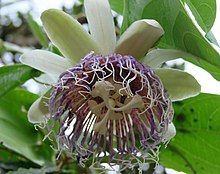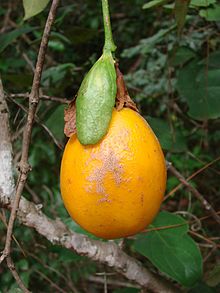| Bell apple | |
|---|---|

| |
| Passiflora nitida flowers | |

| |
| Passiflora nitida fruit. | |
| Scientific classification | |
| Kingdom: | Plantae |
| Clade: | Tracheophytes |
| Clade: | Angiosperms |
| Clade: | Eudicots |
| Clade: | Rosids |
| Order: | Malpighiales |
| Family: | Passifloraceae |
| Genus: | Passiflora |
| Species: | P. nitida
|
| Binomial name | |
| Passiflora nitida | |
Passiflora nitida, the bell apple, is a tasty, but relatively unknown passion fruit.[1] It is similar to P. laurifolia, with orange-yellow fruits that have a sweet, succulent pulp. It is a fast-growing tropical vine. Its flowers are blue and red, a bit like P. laurifolia and P. quadrangularis. The fruits grow up to 4 centimetres (1.6 in). The exact hardiness in unknown, but it is tropical and should be protected from prolonged temperatures below 50–55 °F (10–13 °C). It is not frost hardy. Passiflora nitida is the cousin of almost all the Passiflora species like P. actinia, P. flavicarpa, P. loefgrenii and so on. Its propagation is by seeds. The fruits are eaten fresh and reportedly quite good in flavor. The bell apple is a native to the Amazon jungle region. Passiflora nitida is also a useful fruit in a drink called Purple Passion. Passiflora nitida has one of the widest geographic ranges. It grows in the tropical lowlands from Costa Rica in the north and French Guiana in the northeast, through wide parts of Brazil.
References[edit]
- ^ Montefusco-Pereira, Carlos Victor; de Carvalho, Maria José; de Araújo Boleti, Ana Paula; Teixeira, Lorisa Simas; Matos, Humberto Reis; Lima, Emerson Silva (July 2013). "Antioxidant, Anti-inflammatory, and Hypoglycemic Effects of the Leaf Extract from Passiflora nitida Kunth". Applied Biochemistry and Biotechnology. 170 (6): 1367–1378. doi:10.1007/s12010-013-0271-6. ISSN 0273-2289.
Well, that’s interesting to know that Psilotum nudum are known as whisk ferns. Psilotum nudum is the commoner species of the two. While the P. flaccidum is a rare species and is found in the tropical islands. Both the species are usually epiphytic in habit and grow upon tree ferns. These species may also be terrestrial and grow in humus or in the crevices of the rocks.
View the detailed Guide of Psilotum nudum: Detailed Study Of Psilotum Nudum (Whisk Fern), Classification, Anatomy, Reproduction